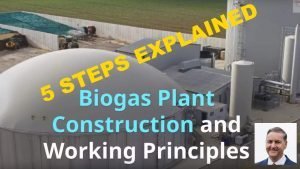 The secret to understanding the most common biogas plant construction and working stages, is explained here for he most common AD plant type.
The secret to understanding the most common biogas plant construction and working stages, is explained here for he most common AD plant type.
By far the most common biogas plants are those based upon one single anaerobic digestion tank, and they are often known as “Continuous Stirred Tank Reactors” (CSTRS).
They are often called single stage biogas plants, which can be confusing, because to the onlooker there would seem to be many more tanks and “stages”.
Tanks are added to increase the amount of biogas produced, and for other uses.
Just remember that for making biogas it is the number of stages in which the methane making bugs grow to make the biogas, that count.
We will now provide an explanation of the way a biogas plant works, in 5 “steps”:
Step 1 – Feeding The Bacteria That Make Biogas
Organic input materials such as silage, foodstuff remnants, fats or sludge, are fed into the biogas plant as what is called “substrate” – that's food for the biogas making bugs, to you and me!
Renewable resources such as corn, beet, or grass, can serve as feed both for animals such as cows and pigs as well as for the micro-organisms in the biogas plant.
Not only those foods work, so do farm wastes such as manure, dung, and chicken litter, plus increasingly biogas is being made from supermarket and household food waste.
Step 2 – Fermentation in the Large Tank (Digester Tank)- where the bacteria make the biogas.
In the fermenter, heated to approx. 38-40 °C, the substrate is decomposed by the micro organisms under exclusion of light and oxygen. The final product of this fermentation process is biogas with methane as the main ingredient. But, at the same time some other unwanted compounds form a small part of the biogas. Pure biogas is just methane alone. But the raw biogas that emerges can be bad smelling from corrosive hydrogen sulphide. Carbon dioxide is also produced and a percentage is contained in the biogas.
Step 3 – Fermentation Residues Storage Tank
Once the substrate has been fermented, it is pumped to the fermentation residues end storage tank and is retrieved from there for making useful products.
The residues, are called “digestate” and these comprise both a fibrous solid part and a liquid part, and these can be utilised as high quality fertiliser, and a soil conditioner respectively. The advantage of digestate is that it has a lower viscosity than farmyard manure, and it therefore penetrates into the ground more quickly than liquid manure slurry. Furthermore, the fermentation residue usually has a higher fertiliser value than manure, and is less odorous.
Further treating the fibrous part, by leaving it to mature in wind-rows, and subsequently using it as dry fertiliser is also common.
Step 4 – Using the Biogas
The biogas part of the output is usually stored in the plastic roof of the tank. From there it is most often burned in a combined heat and power ( CHP ) plant to generate electricity and heat.
The electric power is fed directly into the power grid.
The heat generated can be utilized to heat buildings, to dry firewood, or to dry harvest products such as grain.
At an increasing number of biogas plants the quality of the raw biogas is upgraded to purify it. The carbon dioxide, hydrogen sulphide, and other impurities are removed, and it is compressed and used as a clean renewable transport fuel.
Step 5 – Delivery of Biogas to Users
The biogas power which is not used in running the biogas plant, is exported as either a supply to the national grid or to gas filling stations.
What Others are Saying About Biogas Plant Construction and Working Stages
Build a Biogas Plant – Biogas Plant Construction Resources Available Online
The biogas plant construction download page is divided into two sections. The Home section has smaller family sized units and the Village section has larger or community sized construction plans. via BuildaBiogasPlant
Biogas Plant Construction Manual
A biogas plant construction and working well is an anaerobic digester of organic material for the purposes of treating waste and concurrently generating biogas fuel.
The treated waste is a nutrient-rich, nitrogen-rich fertilizer while the biogas is mostly methane gas with inert gases including carbon dioxide and nitrogen. Biogas plants are a preferred alternative to burning dried animal dung as a fuel and can be used for the treatment of human waste. Other feedstock which can be used includes plant material, non-meat or grease food-wastes, and most types of animal dung.
Over a million biogas plants have been constructed in the developing world for treatment of organic wastes, alternative energy supply to direct burning in the home, and overall improvement of human health and the environment. Many factors for selection of feedstock and site location must be researched before deciding to install a biogas plant.
Successful construction of the biogas plant requires a proper design and adherence to follow correct construction methods. The success or failure of any biogas plant primarily depends upon the quality of construction work.
The following instructions are based on the step-by-step instructions from the Government of Nepal Biogas Support Program Gobar Gas and Agricultural Equipment Development Company of Nepal has developed the design for model 2047 biogas plant.
This biogas plant model has become prolific across Asia and is known as a fixed-dome plant. The advantages of the fixed dome plant include the simplicity of design, few moving parts, low cost to construct and low maintenance.
The disadvantages when compared to a floating-dome digester are primarily the inability to store gas for use on demand; gas from the fixed dome digester must be used as generated or expelled to avoid damaging the digester. April 2011 United States Forces – Afghanistan Page 1 of 24 1. via Construction Manual
How to Build a Medium Sized Biogas Plant
Before selection of tanks, I need to consider how much of digestible kitchen and garden waste I could collect everyday for feeding the tank. In my case I can easily collect between 3.5 to 4 kilogram of waste from kitchen and home garden.
This quantity will be sufficient for a biogas plant with 700 to 800 liter capacity digester tank. Since only 750 liter capacity tanks are available in the market, I have selected a 750 liter tank to be used as the digester.
A simple thumb rule for a biogas plant construction and working plant for home use, is 5 kilograms of waste needs a 1000 litre capacity digester. via Instructables
Biogas Plant Construction and Working Stages
The success or failure of any biogas plant mainly depends upon the quality of construction works.
To come to a successfully constructed biogas plant, the mason should not only respect the dimensions as indicated on the drawing but also follow the correct construction method.
Here under, in a step-by-step fashion, the right construction method of the 2047 design GGC model biogas plant is given. via Nepal Biogas
Biogas Plant Construction and Working from Biogas Plants WBDG
An anaerobic digestion system is made up of several key components, including:
- Manure or other feedstock collection systems and handling to prepare the biomass feedstock material and feed it into the digester
- Anaerobic digesters
- Biogas handling systems
- Biogas use (utilization) devices.
On sites where a manure collection system is needed to gather manure and transport it to the digester. Existing liquid/slurry manure management systems can readily be adapted to deliver manure to the anaerobic digester.
Anaerobic digesters, commonly in the form of covered lagoons or tanks, are designed to stabilize manure and optimize the production of methane.
A storage facility for digester effluent, or waste matter, is also required. In the biogas handling system, biogas—a product of the decomposition of the manure, typically comprising about 60% methane and 40% carbon dioxide, is collected, treated, and piped to a gas use device.
Biogas can then be used to generate electricity, as a boiler fuel for space or water heating, upgraded to natural gas pipeline quality, or for a variety of other uses.
Flares are also installed to destroy extra gas and as a back-up mechanism for the primary gas use device. via WBDG Whole Building Design
Biogas Plant Construction and Working Stages – Homemade ideas and science projects
Biogas plant design, homemade plant construction plans, Science fair projects tutorials about biogas in Urdu, English. via Biogas Homemade ideas






I’m pleased to find this page. I wanted to thank you for clarifying a few things about biogas plant construction.
Very important information about A D Biogas plant, I want information about compressed biogas as a fuel to automobile.
It is possible to use compressed raw biogas to fuel vehicles. It still requires some treatment of the biogas, but not to natural gas “pipeline quality”. In that case special conversions for the vehicles using the compressed biogas will be needed. I believe this has been done in countries like Sweden. However, the fast growing trend is to upgrade the raw biogas to natural gas “pipeline quality” (biomethane). Once that is done the biogas fuel is equivalent to natural gas,. You can compress your biomethane and use the Compressed Natural Gas (CNG) and Liquefied Natural Gas (LNG) fuel vehicles sold by some of the leading car manufacturers. The use of CNG and LNG for vehicle fuel is described at the US Energy Website here.